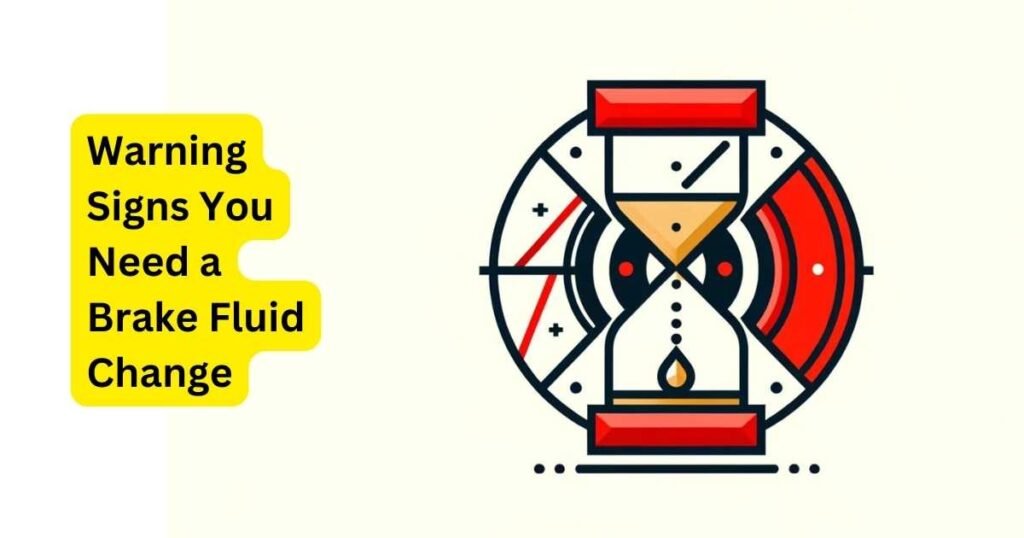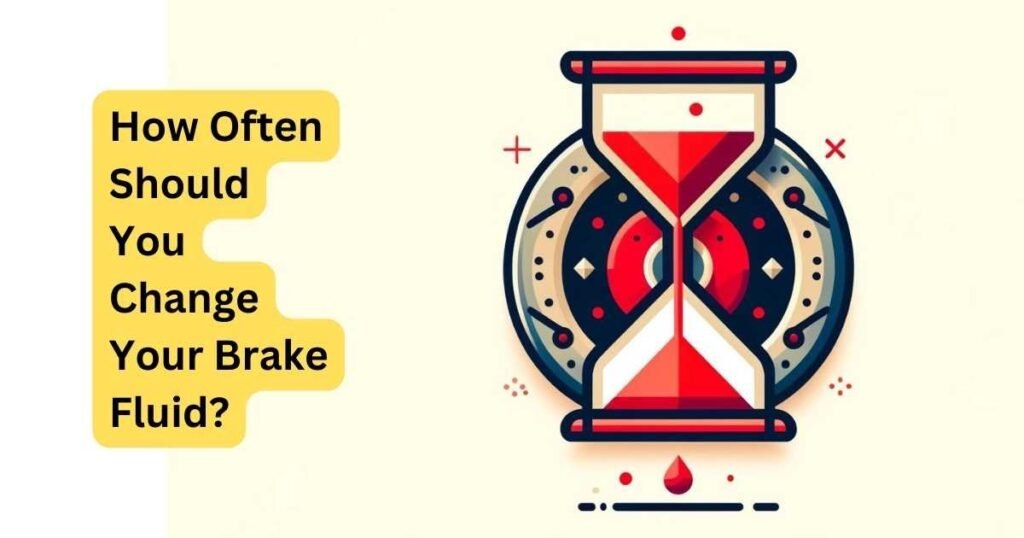Keeping your car safe and working well means looking after many parts, including the brakes. Brakes help you stop your vehicle safely. It’s good to check the brake pads and the discs they press against, but don’t forget about the brake fluid. This fluid helps the whole brake system work smoothly.
You should check your car manual to determine when to change your brake fluid. Car makers suggest changing the brake fluid every two to three years or every 30,000 to 45,000 miles. This keeps your brakes working well and keeps you safe on the road.
Key Takeaways:
- Check your vehicle’s manual for specific brake fluid change intervals.
- Moisture absorption by brake fluid can reduce its effectiveness and safety.
- Regular changes prevent system corrosion and maintain brake reliability.
Table of Contents
What is Brake Fluid, and Why is it Important?
Brake fluid is very important for your car’s brakes to work properly. It helps push the brake pads against the rotors, slowing down your car’s wheels.
Brake fluid must be very strong because it faces high pressures and temperatures when braking. It also must not boil or break down over time.
Plus, it helps keep the brake system from rusting, which keeps your brakes working well for a long time.
Why Does Brake Fluid Need Changing?
Brake fluid absorbs moisture, which makes it hygroscopic. This means it can draw water vapor from the surrounding air. When water enters the brake fluid, it lowers the fluid’s boiling point.
This becomes a problem during intense driving, such as frequent braking. The brake fluid heats up and if there’s water in it, it may start to boil.
This boiling creates vapor bubbles in the brake lines, which compress easily.
As a result, the brake pedal becomes less firm and the brakes may not work as well. This condition, known as brake fade, can be dangerous.
Additionally, water in the brake fluid can cause parts of the brake system to rust and wear out more quickly. This can lead to leaks or even broken parts. That’s why it’s crucial to keep your brake fluid fresh and clean.
How Often Should You Change Your Brake Fluid?
Knowing when to change your car’s brake fluid has few answers. Different car manufacturers have different recommendations.
Some suggest changing the brake fluid based on how many miles you’ve driven—usually between every two to three years or every 30,000 to 45,000 miles. Others recommend changing it based on time, like every two to four years.
The best way to find out when to change your car’s brake fluid is by checking its owner’s manual.
Here’s a simple table to show you when you might need to change your brake fluid based on how you drive and the conditions you drive in:
| Driving Conditions | Recommended Change Interval |
| Normal | Every 3-4 years or 60,000 miles |
| Heavy Traffic/Stop-and-Go | Every 2-3 years or 45,000 miles |
| Performance Driving | Every 1-2 years or 20,000 miles |
Changing your brake fluid isn’t just about strict mileage. Brake fluid absorbs moisture from the air, making it less effective when it gets hot.
This can cause your brakes to perform poorly, which is unsafe. If you don’t use your car often, you may need to change the brake fluid sooner than expected, regardless of the miles driven.
How can I check the condition of my brake fluid?
Knowing when to change your brake fluid involves watching for certain signs. Does your brake pedal feel soft or mushy when you press it?
This might mean the air in the brake lines or the brake fluid is old and contaminated with moisture. If your brake pedal feels off, checking the fluid is a good idea.
Another indicator is the brake fluid level in your car. A low level could point to a leak. Brake fluid can also absorb moisture from the air, which might make it expand and appear low.
Some newer cars have a dashboard light that alerts you to brake fluid issues. This light may turn on if the fluid level is too low or the fluid is old and overly moist.
You can also check the brake fluid yourself. Most cars have a visible brake fluid reservoir marked with “min” and “max” lines.
Fresh brake fluid should look light, amber, or clear. It might be time to change if it’s dark brown or cloudy.
These tips are helpful, but if you’re unsure, having a mechanic check your brakes is safest.
What are the warning signs that you need a brake fluid change?
When you notice specific signs, it might mean that your brake fluid needs to be checked. Here’s what to look out for:
If your brake pedal feels soft or mushy when you press it, this might mean there’s air in the brake lines. Air can enter the lines if the brake fluid is old or malfunctioning.
You might also notice that your car takes longer to stop than it used to or that its brakes feel uneven. These can be signs that the brake fluid isn’t doing well.
Sometimes, your dashboard’s Anti-Lock Braking System (ABS) light will light up. This can happen if there’s a problem with your brake fluid.
If you smell something burning while braking, it could mean your brakes are getting too hot. This might be happening because there’s an issue with the brake fluid.
If you notice any of these problems, having a qualified mechanic check your brakes is a good idea. They can make sure everything is working right and keep you safe on the road. Top of Form

What Happens if you do not change the brake fluid on time?
Toyota and Honda vehicles are known for their sturdy and reliable hydraulic systems but still need regular maintenance to keep them running smoothly.
One important part of this maintenance is changing the brake fluid on time. If you don’t replace your brake fluid when needed, it can cause serious problems.
Brake fluid helps your car to stop when you push the brake pedal. Over time, this fluid can get dirty or low.
If this happens, your brakes won’t work either, and you’ll have to push the pedal harder to stop the car. This is especially risky in emergencies where you need to stop quickly.
Moisture and tiny particles from the brake system, like old rubber hoses and seals, can also contaminate the brake fluid.
This contamination can also mess up your car’s braking system, including the anti-lock braking system (ABS). ABS helps you control the vehicle when you must stop suddenly, so keeping it working right is important.
In the worst case, if your brake fluid gets too low, your brakes might not work. This is very dangerous because it means you could lose the ability to stop your car.
To avoid these risks, check and change your brake fluid as recommended. This keeps your car safe and helps prevent accidents.
How to Change Brake Fluid? Process Explained
Changing your brake fluid is simple at home, or you can have a mechanic do it for you. Here’s how to change the brake fluid:
Start by finding the brake fluid reservoir in your car and removing the cap.
Use a turkey baster or a unique tool called a brake fluid extractor to remove the old brake fluid. Once you’ve removed the old fluid, pour new brake fluid into the reservoir.
Next, you’ll need to bleed the brake system to remove any air bubbles in the brakes. This step is crucial for ensuring your brakes work well.
If your car has multiple brake fluid reservoirs, repeat these steps for each one.
If you’re unsure about doing this, let a mechanic handle it. They will ensure that your brakes are well-maintained and safe to use.
What Precautions should I keep in mind before changing brake fluid?
Changing your brake fluid is vital for keeping your car running safely. Here’s a simple guide on how to do it correctly:
First, always check your car’s owner’s manual or consult a mechanic to determine the correct type of brake fluid for your vehicle. It’s crucial because using the incorrect fluid can lead to brake issues.
Before you begin, make sure to wear protective gloves and eyewear. Brake fluid can be harmful, so protecting your eyes and skin is essential.
Be extra cautious not to spill brake fluid on your car’s paint or other parts, as it can cause damage. If you do spill, clean it up promptly.
To change the fluid, you first need to remove the old brake fluid. Remember to dispose of it properly since it’s harmful to the environment.
When adding new fluid to your brake system, ensure there are no air bubbles. This step, known as bleeding the brakes, is crucial for preventing your brakes from malfunctioning.
Finally, always use the right tools and adhere to safety guidelines. This will ensure that your brake fluid change is done correctly and keeps you safe.
By following these steps, you can make sure your brake fluid change keeps your car in top condition.
What are the Brake Fluid Types and their Compatibility?
Brake fluid is crucial for ensuring your car’s brakes function correctly. There are several types you might encounter:
DOT 3 is commonly used in everyday vehicles.
DOT 4 is preferred for faster and more powerful cars.
DOT 5 is designed for race cars, which require rapid and reliable stopping power.
DOT 5.1 is ideal for vehicles equipped with an Anti-lock Braking System (ABS), which helps prevent the brakes from locking during sudden stops.
When it’s time to add or change the brake fluid, selecting the appropriate type is essential.
You can find the right kind by checking your car’s owner’s manual or consulting a mechanic. They can advise on the best fluid for your car’s braking system.
How much does a brake fluid change typically cost?
The cost of a brake fluid change can vary depending on your location, car type, and the specific shop you choose. A professional brake fluid flush costs $80 to $130 on average.
Several factors determine the cost of changing brake fluid. Labor costs are a major part of the expense, as the process usually takes a mechanic 1-2 hours.
The type of brake fluid you choose also affects the price. The cost varies based on the DOT rating and brand, but this is usually a minor expense compared to labor.
Additionally, labor rates can differ depending on the location of the repair shop.
You also like reading this: How Much Is A Transmission Fluid Change Cost At Valvoline?
Final Thought
Regularly changing your brake fluid is crucial for maintaining optimal brake performance and safety. Follow manufacturer recommendations, usually every 2-3 years or 30,000-45,000 miles. This prevents moisture accumulation and degradation, ensuring your brakes work effectively and reducing the risk of accidents.


